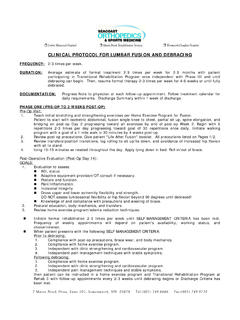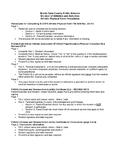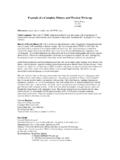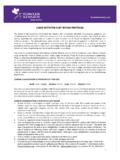Transcription of Aqua Lymphatic Therapy in Managing Lower …
1 179 VOLUME 5, NUMBER 4 APRIL Support Oncol 2007;5:179 183 2007 Elsevier Inc. All rights O W W E D O I Tings, continued skin care, remedial exercises, and repeated ,11 Because lymphedema is a chronic disorder, the major shortcoming of the maintenance phase is sustaining the patient s com-pliance with required preventative ,11A novel approach to the lymphedema main-tenance phase is aqua Lymphatic Therapy (ALT), which provides patients in the maintenance phase of lymphedema with the opportunity to treat them-selves in a group setting. The program is directed by a physical therapist only once weekly. However, lymphedema must be treated on a daily basis; thus, the ALT is an active method performed entirely by the patient and not by the physical therapist.
2 Dur-ing the weekly group session, the physical therapist measures girth before and after each treatment ses-sion to monitor the effectiveness of treatment and to enable patients to track and modify their indi-vidual maintenance plans. Although aquatic ther-apy has been used to reduce edema in patients with musculoskeletal conditions, no researchers have studied this technique for lymphedema reduction in that ,13 ALT combines the inherent properties of wa-ter with self-massage, exercise, and compression to provide patients with an effective, pleasurable, and inexpensive method to control This article will describe the ALT technique using a case description of a woman with vulvar DescriptionA 49-year-old woman (Mrs. J) was diagnosed with vulvar cancer in August 1998.
3 She subsequent-ly underwent vulvectomy with bilateral inguinofem-oral lymph node dissection; adjuvant radiotherapy resulted in grade 1 burns to the anus, Lower abdo-men, and inguinal area. Two months after radiation Therapy ended, she developed limb volume of Mrs. J s lymphadematous left Lower extremity was 1,739 mL higher than that of her right Lower extremity (difference between limbs, 20%; stage II moderate lymphedema).10 The initial physical Therapy evaluation revealed swelling Correspondence to: Dorit Tidhar, BPT, Macabbi Healthcare Service, Box 140, Qlahim, Israel; telephone: +972 77 7080618; fax: +972 77 70801618; e-mail: Tidhar is an aqua Lymphatic Therapist, Department of Physiotherapy, Macabbi Healthcare Services, Netivot, Israel.
4 Dr. Drouin is Assistant Professor, Department of Physical Therapy , University of Michigan-Flint, Flint. Dr. Shimony is a mem-ber of the Department of Cardiology, Soroka University Medical Center, Ben Gurion University, Be er Sheba, Lymphatic Therapy in Managing Lower Extremity LymphedemaDorit Tidhar, BPT, Jacqueline Drouin, PhD, PT, and Avi Shimony, MDL ymphedema of the Lower extremity is a com-plication that follows treatment for gyneco-logic The prevalence of Lower ex-tremity lymphedema in women treated for these malignancies reportedly is 30%. However, among women with vulvar cancers who undergo removal of the inguinofemoral lymph nodes and radiother-apy, the prevalence increases to 47%.1,2 The risk factors for lymphedema includes early complications that occur after lymphadenectomy (eg, wound breakdown or infection, lymphocyst formation, early lymphedema).
5 3 Signs and symp-toms for leg lymphedema are pain, swelling, re-duced range of motion, muscle weakness, genital lymphedema, and difficulty with such activities of daily living as sitting or , this condition does not cause only physical discomfort. Chronic lymphedema pro-duces high levels of psychological stress, because patients perceive themselves to be different from their peers and often cannot continue their usual Therefore, maintaining the stability of the Lower extremities may promote better mental health and quality of treatment for lymphedema consists of an acute, or intensive, treatment phase and a maintenance phase. In the acute phase, the physi-cal therapist performs complex Lymphatic Therapy (CLT), which consists of decongestive massage, compression, exercise, and skin ,6 Acute-phase treatments are performed on most days of the week until limb volume is reduced and stabilized optimal-ly.
6 This typically occurs within 2 3 weeks,7,8 although Boris et al9 reported a Lower extremity lymphedema reduction of after the acute volume is stabilized, the patient enters the self-directed maintenance phase, which may include compression by low-stretch elastic JOURNAL OF SUPPORTIVE ONCOLOGY Exercise element: Exercises are performed in the pool to al-low the patent to benefit from the properties of the water The viscosity of water provides resistance to body movement, which promotes strengthening and improves Lymphatic clear-ance. Since water resists movement in any plane, a variety of limb movements may be used to provide differing pressures on the skin; this may improve pumping of the Lymphatic factors inherent to the treatment itself are important to the success of TEMPERATUREW ater conducts heat; therefore, capillary vasodilation and swelling may be prevented by using thermoneutral wa-ter.
7 The recommended water temperature ranges are 29 C for vigorous activities (eg, swimming) and 33 C for light ac-tivities (eg, walking).16,17 Water temperatures below 31 C should be avoided during moderate-intensity water activities, since insufficient energy or heat is produced from such exercise, and resultant shivering may cause muscle spasms. Therefore, ALT is conducted at a temperature range between 31 C and , 15 THE POOL The hydrotherapeutic pool is a 11 x 15-m vessel with a graduated depth of m. It is monitored for pH ( ), chloride concentration, bacteriologic control, and water clar-ity. Participants with active infections are not allowed to enter the pool; they must receive physician clearance before they can return to AND ORGANIZATIONThe ALT sessions are held in a group situation, which has shown advantages over individual ,19 During each session, a maximum of 8 people are allowed in the pool.
8 The and fibrosis in the genitals and in the involved Lower extrem-ity, especially around the radiated inguinal area. The fibrosis in the inguinal area restricted thigh extension beyond neutral. Her medical history also included atopic urticaria and approximately years, Mrs. J had received CLT; dur-ing that time, however, she suffered from exacerbations and compliance difficulties. She was introduced to ALT during her self-maintenance phase, when she attended a lecture on lymphedema self-management at the hydrotherapeutic center near her home and consulted with a lymphedema she began the ALT group Therapy program, Mrs. J had a 16% excess volume in her left Lower extremity as compared with her right Lower extremity (stage I mild lymphedema).
9 11 She attended the group sessions once weekly for 18 months. Further, she wore a compression garment only during the day-time hours between sessions and continued swimming twice weekly. Measurements were taken of her involved limb be-fore and after each session and of her right, healthy limb three times during the 16-month of ALTALT uses the physical properties of water, self-massage, and exercise to maintain the positive effects of lymphedema reduction achieved during the intensive treatment phase of CLT. Each ALT session includes the following elements: Skin care: Patients apply a silicone cream to protect the skin before each session. Manual element: Patients perform self-massage and wa-ter massage. Compression element: The hydrostatic pressure of water at 32 C increases lymph flow and evacuation of The hydrostatic pressure of water gradually increases with greater depth; thus, the limb benefits from pressure gradients, which influence the direction of Lymphatic Lymphatic Therapy in Managing Lower Extremity LymphedemaFigure 1 Movements in aqua Lymphatic Therapy (A) This chest breathing exercise clears the lymph reservoir (starting position).
10 (B) Clearing the axiliary lymph nodes involves squeezing from the chest up into the armpits (starting position). (C) Proximal movements; the side bend activates the latissimus dorsi and quadratus lumborum muscles for proximal work. (D).Diving causes water massage upward over the skin and changes in hydrostatic pressure on the Lower 5, NUMBER 4 APRIL therapist, who is a certified lymphedema therapist, stays in the water during the entire session to supervise and in-struct patients. Each session is held for 1 hour once OF LIMB VOLUMEAs will be discussed, patients limbs are measured regularly us-ing a tape measure. The volumeter is considered to be the gold standard for measuring lymphedema. However, this tool is not used clinically, because it is time-consuming to operate, is not portable, and may be unhygienic.






